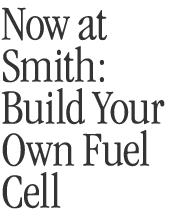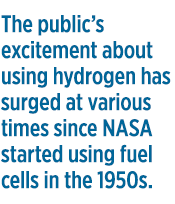
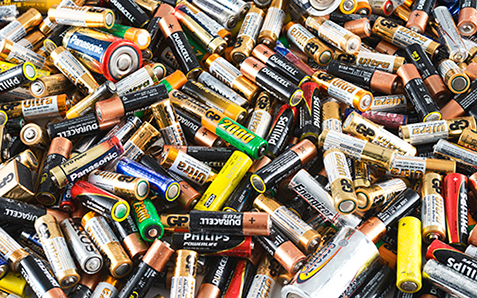
Producing and then disposing of lithium-ion batteries for decades and eventually centuries into the future is not sustainable, says engineering professor Denise McKahn. She is currently conducting research in her Smith lab to create hydrogen fuel cells that can be used as alternative energy and are safer for the environment.
/ Published September 8, 2016
Associate Professor of Engineering Denise McKahn has her sights set on creating hydrogen fuel cells that perform more efficiently and are safer for the environment than lithium-ion batteries for powering small portable devices. She is using weather balloons as a test case.
This is a big deal, not just because improving existing technology is one of the objectives of engineering but also because it adds to a raging debate in the engineering and policy-making communities about the evolving energy infrastructure.
What will energize the future?
As McKahn sees it, we are making enormous advances in solar and wind power technologies as efficiency increases and prices come down. Photovoltaic panels and wind turbines will put more and more electricity generated by renewable sources on the grid. We are also investing in making the grid “smarter” to handle new patterns of electricity generation and distribution.
This is all part of weaning ourselves from carbon and heading off catastrophic climate change.
Unfortunately, electricity has its own disadvantages: without batteries, it is not easily portable beyond its transmission lines, and it is hard to stockpile.
That is why scientists like McKahn and others concerned about the future are looking to hydrogen as a way of attacking a problem that has to be solved if we are to kick our fossil fuel habits.
She makes her case beginning with a brief science lesson.
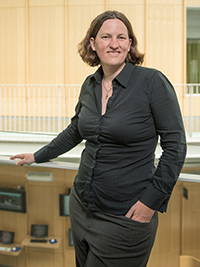
Denise McKahn
Basically, hydrogen can be extracted from compounds like water by isolating it. To do this requires electricity. An electric charge applied to water can separate it into its two elements, hydrogen and oxygen, in a process known as electrolysis. The resulting hydrogen can then be transported in a hydrogen fuel tank and either burned or, using fuel cells, turned back into electricity at will.
“I call hydrogen an energy carrier,” says McKahn. “It’s a way of holding energy and moving it around so it can be used in different places at different times.”
The kind of fuel cell McKahn builds in her Ford Hall laboratory is called the polymer electrolyte membrane (PEM). It is essentially a stack (or sandwich) of plates and wires made of common materials like steel, graphite and plastic. The plates have grooved channels that diffuse an even supply of hydrogen to one side of an electrically conductive membrane and air to the other. The membrane has a layer of platinum on the surface, which is the catalyst for the process.
“When you have hydrogen and oxygen play with each other nicely and perfectly, they combine into water,” says McKahn. And since they are going into a lower energy state, they give back some of the electricity it took to separate them.
McKahn favors hydrogen over batteries as a way of carrying electrical energy to where it needs to go for one overriding reason: the lithium in the lithium-ion batteries, which are part of just about everything rechargeable, is dangerous to the workers who mine it. Likewise, it is destined to eventually become hazardous waste somewhere. Not only do we rely on these batteries for our cell phones, they are now also central to all hybrid electric vehicles and will become a significant component in a smarter electricity distribution network.
Unfortunately, producing and then disposing of lithium-ion batteries for decades and eventually centuries into the future is not sustainable.
McKahn’s doctoral work in environmental engineering at the University of Michigan put her in the thick of hydrogen fuel cell research at the big three American car manufacturers. She is a distinguished alumna of the university’s Automotive Research Center.
The feel of driving a hydrogen fuel cell vehicle is similar to driving a gasoline car. Prototypes of hydrogen-fueled cars now in existence get a range of 300 to 400 miles on a tank of hydrogen. Fueling takes about three minutes.
All that comes out of the tailpipe is water vapor.
The down side is that energy is lost along the way. The amount of electricity that comes out of a fuel cell is less than half the electricity it took to create the hydrogen fuel. The rest of the energy is lost as low-grade heat on both sides of the splitting and uniting processes.
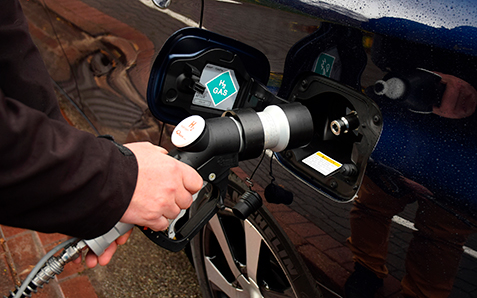
Most of the big car companies have labs working on hydrogen technology, and some have pilot programs with small fleets of experimental vehicles.
However, as McKahn points out, gasoline isn’t free energy either. As oil reserves dwindle, it takes more and more energy to find, extract, transport, refine and deliver a gallon of gas. Add to that the military costs of protecting access to oil together with the consequences of putting more and more carbon into the atmosphere, and you have a wildly inefficient energy equation.
Batteries are more efficient than hydrogen cells for storing electricity in the short run, but it also takes energy to produce and charge batteries, and they are only good for a finite number of charges. Add to that the toxicity of lithium that McKahn keeps coming back to, and the way forward is clear. We will someday arrive at a hydrogen-based economy, she says; the question is when.
In her work with the Schatz Energy Research Center, McKahn participated in designing and building million-dollar roadworthy prototypes. Most of the big car companies have labs working on hydrogen technology, and some have pilot programs with small fleets of experimental vehicles. There are cars on the market for early adopters of means, especially if they live in California where a small but growing network of hydrogen fueling stations has taken root.
Up, Up and Away
At Smith, McKahn has turned her attention to the portable power needs of weather balloons for a few reasons. A colleague in the engineering department, Paul Voss, an associate professor and atmospheric scientist, uses balloons for his research, giving McKahn ready access. Balloons are different from other vehicles because when they are in the air, McKahn doesn’t have to keep the hydrogen compressed, so she doesn’t have to worry so much about the volume the fuel takes up.
“The balloon is the excuse,” says McKahn. “I am advancing portable applications for fuel cells and really more than anything keeping the conversation of hydrogen going.”
Typically balloons have a small battery-powered motor on board that can be controlled remotely to pump air in and let it out, making them go up and down.
McKahn takes an athlete’s glee in describing how her small hydrogen fuel cells are on the verge of beating batteries on important measures of efficiency and performance. Year after year, she has been keeping pace with the U.S. Department of Energy’s technical targets.
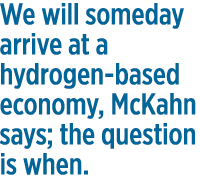
Much of her experimentation with portable fuel cells for applications like balloons is to reduce mass and make the fuel cells as light as possible. This includes theorizing about the groove patterns on the plates that channel the hydrogen and air before they are exposed to each other. Then she tests her theories with little fuel cells she builds in the lab.
“I’m playing a game,” she says. “I am trying to decrease the mass, which means that I am trying to decrease the thickness” of every component. Part of that is figuring out the “channel configuration” that best achieves her objectives. “Should it be a square channel? Should it be a triangle? What depth does it need to be? Because the deeper it is, the thicker the plate has to be....I wrote a whole paper on just that,” says McKahn.
She is also experimenting with the way the fuel cell distributes the electricity to the balloon to wring every ounce of efficiency out of something that will be tested under harsh conditions in remote parts of the world where the weather can get icy, steamy and violent. If hydrogen fuel cells someday become the standard way to power a balloon, fewer of the poisonous lithium-ion batteries would be lost in far-flung places.
Likewise, she believes there is value in people becoming accustomed to looking to fuel cells instead of batteries for other power needs as well. Unfortunately, in the case of automobiles, those that run on lithium-ion batteries and the beginnings of a recharging infrastructure to support them are currently proliferating more quickly than hydrogen-fueled cars. This is in large measure because the government has been funneling more research money to batteries than to fuel cells.
McKahn thinks that’s too bad because the lithium underlying the electric car technology is an “incredibly caustic and nasty material....We are completely confusing everything if we are running around saying, ‘if we just go electric that solves all our problems.’ It doesn’t solve our problems.
“If we scale up to convert all of our vehicles to lithium-ion batteries, the scale is immense, and I don’t think we are really thinking that all the way through,” she explains. “These materials have a huge environmental impact and they have a short lifetime.”
Whether she is working on cars or balloons, McKahn is dedicated to improving the efficiency of hydrogen fuel cells on every front. “My goal is to beat lithium-ion batteries because if I could beat them on performance, then we’re done with them,” says McKahn. “The active debate now is lithium-ion verses anything.”













